In 2014, following a wave of US and European Union sanctions on Russia in response to its annexation of Crimea, Russian President Vladimir Putin initiated his “Pivot to the East” (povorot na vostok). The strategy aims to shift the Russian economy away from its European partners and toward Beijing. Despite a minor economic downturn in both countries disrupting the strategy in 2015, the reorientation was largely successful in integrating their respective economies. China’s share of Russia’s total trade grew from around 10 percent in 2013 to 18 percent by the end of 2021.
Russia’s 2022 invasion of Ukraine, as well as G7 sanctions imposed in retribution, have expedited Moscow’s pivot to Beijing. While Russia’s economic reorientation has most prominently played out in its goods trade, particularly with hydrocarbons, Russia’s financial relationships have undergone a parallel shift. As a result, Russia’s economy is now heavily reliant on Chinese capital. Though this may be favorable for Russia now, overreliance on Chinese finance will reinforce Russia’s status as the junior partner in the two countries’ relationship.
Chinese authorities do not publicly report their banks’ consolidated positions, but alternative data sources suggest that Chinese lenders may have maintained or extended additional credit to Russian borrowers in the aftermath of Russia’s invasion of Ukraine. One notable example is syndicated lending—a type of loan provided by a group of lenders and preferred by international financiers, as it allows them to share risk. Syndicated lending data suggests loans originating from Chinese banks now account for nearly half the global total of syndicated loans to Russia. In the coming months, this overreliance will likely grow as financial institutions in other parts of the world, namely Europe, halt new lending to Russia and refuse to refinance or roll over existing loans, with many banks pulling out of the country altogether.
Russia first identified China as a viable source of alternative financing in 2014 after Moscow found itself blocked or ostracized in the Western financial hubs of London and New York. Hoping to instead rely on Shanghai and Hong Kong, Russia began to more intentionally engage Beijing to foster a stronger economic and financial relationship. The Kremlin lifted political barriers such as a ban on asset purchases in the natural resource sector and investment in infrastructure contracts in sensitive industries like roads and railways. Beijing, in turn, encouraged its firms to invest or enter the Russian market. Borrowers and lenders followed, and the portion of Chinese lending in the Russian economy tripled from where it stood in 2014 to 2022.
Although Moscow began to look elsewhere for its financing, not all European financial institutions saw the writing on the wall. While the UK, France, and Germany viewed Russia’s 2014 annexation of Crimea as an inflection point in their relationship with the Kremlin and began to reduce their exposure to Russia, Italy, and to a lesser extent Austria, did the opposite. Driven by a combination of high returns and a domestic political climate with more favorable views towards Russia, Italian banks increased their syndicated loan exposure to Russia from around 4.6 percent in the months following the seizure of Crimea to around 7.5 percent going into Q3 2022. Italy’s banking sector, led by the banking group UniCredit, is now forced to deleverage itself from Russia by writing off its cross border exposure, swapping loans with Russian banks, and identifying international buyers for its loans to Russian clients.
Beware of financial overreliance
While the Kremlin’s eastern pivot worked well in the aftermath of 2014 when the Chinese economy was booming, today Shanghai and Hong Kong may be less willing to fill the new gaps that are opening as Western lenders exit the Russian market. Chinese lending is typically shaped by the geopolitical and economic objectives of the Chinese Communist Party. In 2014, this benefited Russia. The Chinese economy was growing at upwards of 7 percent, its financial sector was flush with capital, and its government encouraged its firms to look internationally via a “going out” strategy.
The opposite is now true. In 2022, China grew at a meager 3 percent—well below its target rate of 5.5 percent. Under Beijing’s direction, its financial sector is now focused on ensuring ample liquidity in domestic markets and low funding costs for businesses. Consequently, Chinese international lending has dropped by around 14 percent from the start of 2022 to July, when the latest data is available. In the short term, Beijing is far more likely to direct its banks to support its own ailing economy to meet its GDP target than to shore up any gaps opening in Russia.
In the medium to long term, however, Chinese lenders will likely increase their exposure to the Russian economy. As western lenders shun the Russian market, Shanghai and Hong Kong will be able to extract new deals with more favorable terms for China. Russia could provide a friendly market for Beijing to test new financial policies it will eventually need to implement as it opens its own financial system to the rest of the world.
atlanticcouncil.org
